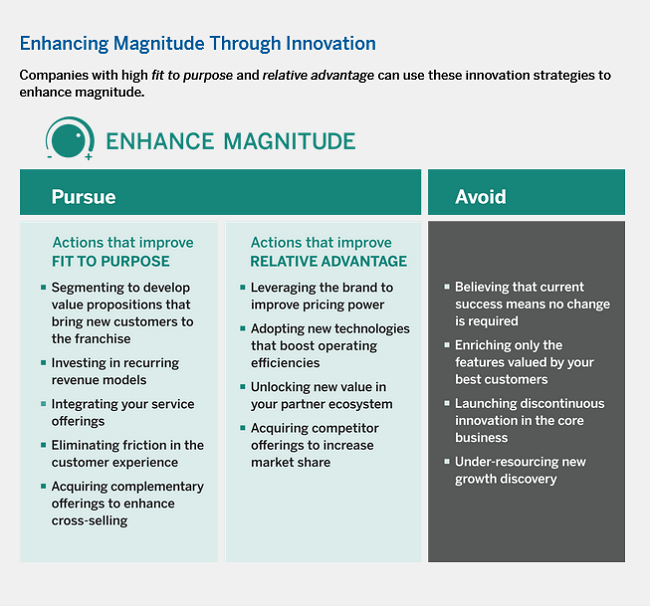Increased Value of Innovation
Introduction
Generally innovation is perceived as an end in itself, rather than the mechanism for achieving change in either magnitude, or activity, or direction.
- magnitude (you need to enhance the execution of the current path)
- activity (you need to adopt new ways of pursuing the current path)
- direction (you need to take a different path).
Innovation should be linked with strategic analysis of where and how it can improve the organisation's purpose, expectations of customers and other stakeholders, and its relative advantage, ie distinctiveness relative to alternatives.
"...is the strategic objective of your innovation primarily to strengthen the direction of your existing path? Or is the imperative to reimagine the tactics used to achieve your strategy because of the declining effectiveness of your current activities? Or is the objective of your innovation to fundamentally reinvent your business..."
Tom Hunsaker et al, 2021a
Types of innovation suitable for 3 primary types of strategic change, ie
"...Change of magnitude amplifies an existing strategy; a change of activity reconceives the tactics used to pursue a strategy; and a change of direction fundamentally reorients the strategy of the business..."
Tom Hunsaker et al, 2021a
A major challenge for organisations
"...is knowing when to stay the course and when to change direction..."
Tom Hunsaker et al, 2020
This involves understanding the roles of perseverance, grit, commitment, ie not changing.
Even though change is inevitable, it is hard to identify the nature, sky and timing of the appropriate change for your organisation.
Innovate to enhance, ie innovation to enhance existing strategy to enhance the customer's experience:
"...it should align with the existing momentum of the business so as to further strengthen what makes it relevant and distinctive to existing customers and what is attractive to new customers..."
Tom Hunsaker et al, 2021a
Some examples include:
- Walmart ( to reduce friction in the customer purchase experience and improve recurring revenue, eg provide next-day delivery to 75% of the US population during the pandemic)
- Maersk (used blockchain to accelerate the previously time-intense tasks involved in locating shipping containers)
- BoMill (grain farmers used AI-powered automated harvesting that graded grain on quality and resulted in around 50% yield spike)
- Roche (efforts focused on ensuring a continuous pipeline of related pharmaceuticals and diagnostics; included in-depth analysis of how to better serve existing customers and attract new ones).
However, there are some companies that got it wrong by doubling down on inappropriate business strategies: Kodak, Nokia, Xerox, Blackberry, Blockbuster, Tower Records, JCPenney, etc. They believed
"... A change of magnitude sufficient instead of either a change of activity,, such as adopting new technology or distribution channels, or a change of direction, such as exiting certain businesses altogether..."
Tom Hunsaker et al, 2020.
Similarly, some organisations have taken risky changes in direction which were not needed, ie instead, they needed a magnitude change of activity. Some examples:
- GE's attempt to be a first mover in green energy and industrial Internet of things
- Sony's move into entertainment content
- Deutsche Bank's efforts to become a global investment bank
Some good examples of change in magnitude are
- the integration of GPS, smart phones and electronic payment systems, etc which facilitates participation in the sharing economy.
- digital transformation is used to enhance execution of the existing strategy by replacing manual and analogue processes with digital ones.
NB It is rare for an organisation to successfully use digitalisation to reinvent itself.

